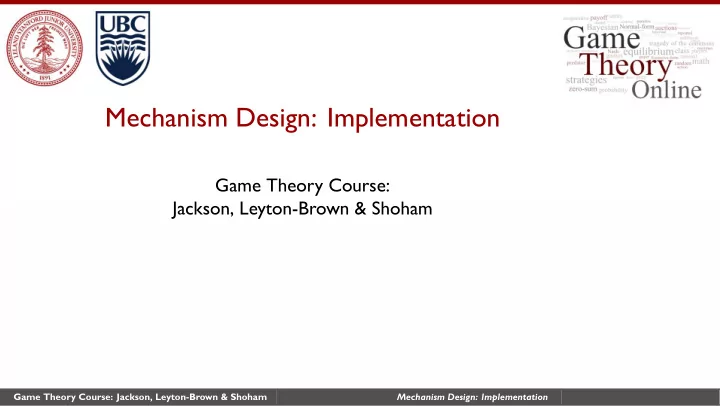

Mechanism Design: Implementation Game Theory Course: Jackson, Leyton-Brown & Shoham Game Theory Course: Jackson, Leyton-Brown & Shoham Mechanism Design: Implementation .
. Bayesian Game Setting • Extend the social choice setting to a new setting where agents can’t be relied upon to disclose their preferences honestly. • Start with a set of agents in a Bayesian game setting (but no actions). . Definition (Bayesian game setting) . A Bayesian game setting is a tuple ( N, O, Θ , p, u ) , where • N is a finite set of n agents; • O is a set of outcomes; • Θ = Θ 1 × · · · × Θ n is a set of possible joint type vectors; • p is a (common prior) probability distribution on Θ ; and • u = ( u 1 , . . . , u n ) , where u i : O × Θ �→ R is the utility function for each player i . . Game Theory Course: Jackson, Leyton-Brown & Shoham Mechanism Design: Implementation .
. Mechanism Design . Definition (Mechanism) . A mechanism (for a Bayesian game setting ( N, O, Θ , p, u ) ) is a pair ( A, M ) , where • A = A 1 × · · · × A n , where A i is the set of actions available to agent i ∈ N ; and • M : A �→ Π( O ) maps each action profile to a distribution over outcomes. . Thus, the designer gets to specify • the action sets for the agents • the mapping to outcomes, over which agents have utility • can’t change outcomes; agents’ preferences or type spaces Game Theory Course: Jackson, Leyton-Brown & Shoham Mechanism Design: Implementation .
. What we’re up to • The problem is to pick a mechanism that will cause rational agents to behave in a desired way • each agent holds private information, in the Bayesian game sense • Various equivalent ways of looking at this setting • perform an optimization problem, given that the values of (some of) the inputs are unknown • choose the Bayesian game out of a set of possible Bayesian games that maximizes some performance measure • design a game that implements a particular social choice function in equilibrium, given that the designer does not know agents’ preferences and the agents might lie Game Theory Course: Jackson, Leyton-Brown & Shoham Mechanism Design: Implementation .
. Implementation in Dominant Strategies . Definition (Implementation in dominant strategies) . Given a Bayesian game setting ( N, O, Θ , p, u ) , a mechanism ( A, M ) is an implementation in dominant strategies of a social choice function C (over N and O ) if for any vector of utility functions u , the game has an equilibrium in dominant strategies, and in any such equilibrium a ∗ we have M ( a ∗ ) = C ( u ) . . Game Theory Course: Jackson, Leyton-Brown & Shoham Mechanism Design: Implementation .
. Implementation in Bayes–Nash equilibrium . Definition (Bayes–Nash implementation) . Given a Bayesian game setting ( N, O, Θ , p, u ) , a mechanism ( A, M ) is an implementation in Bayes–Nash equilibrium of a social choice function C (over N and O ) if there exists a Bayes–Nash equilibrium of the game of incomplete information ( N, A, Θ , p, u ) such that for every θ ∈ Θ and every action profile a ∈ A that can arise given type profile θ in this equilibrium, we have that M ( a ) = C ( u ( · , θ )) . . Game Theory Course: Jackson, Leyton-Brown & Shoham Mechanism Design: Implementation .
. Bayes–Nash Implementation Comments Bayes–Nash Equilibrium Problems: • there could be more than one equilibrium • which one should I expect agents to play? • agents could mis-coordinate and play none of the equilibria • asymmetric equilibria are implausible Refinements: • Symmetric Bayes–Nash implementation • Ex-post implementation Game Theory Course: Jackson, Leyton-Brown & Shoham Mechanism Design: Implementation .
. Implementation Comments We can require that the desired outcome arises • in the only equilibrium • in every equilibrium • in at least one equilibrium Forms of implementation: • Direct Implementation: agents each simultaneously send a single message to the center • Indirect Implementation: agents send a sequence of messages; information may be (partially) revealed about the messages that were sent previously Game Theory Course: Jackson, Leyton-Brown & Shoham Mechanism Design: Implementation .
Recommend
More recommend